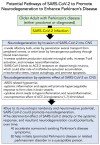Role of SARS-CoV-2 in Modifying Neurodegenerative Processes in Parkinson's Disease: A Narrative Review
- PMID: 35624923
- PMCID: PMC9139310
- DOI: 10.3390/brainsci12050536
Role of SARS-CoV-2 in Modifying Neurodegenerative Processes in Parkinson's Disease: A Narrative Review
Abstract
The COVID-19 pandemic, caused by SARS-CoV-2, continues to impact global health regarding both morbidity and mortality. Although SARS-CoV-2 primarily causes acute respiratory distress syndrome (ARDS), the virus interacts with and influences other organs and tissues, including blood vessel endothelium, heart, gastrointestinal tract, and brain. We are learning much about the pathophysiology of SARS-CoV-2 infection; however, we are just beginning to study and understand the long-term and chronic health consequences. Since the pandemic's beginning in late 2019, older adults, those with pre-existing illnesses, or both, have an increased risk of contracting COVID-19 and developing severe COVID-19. Furthermore, older adults are also more likely to develop the neurodegenerative disorder Parkinson's disease (PD), with advanced age as the most significant risk factor. Thus, does SARS-CoV-2 potentially influence, promote, or accelerate the development of PD in older adults? Our initial focus was aimed at understanding SARS-CoV-2 pathophysiology and the connection to neurodegenerative disorders. We then completed a literature review to assess the relationship between PD and COVID-19. We described potential molecular and cellular pathways that indicate dopaminergic neurons are susceptible, both directly and indirectly, to SARS-CoV-2 infection. We concluded that under certain pathological circumstances, in vulnerable persons-with-Parkinson's disease (PwP), SARS-CoV-2 acts as a neurodegenerative enhancer to potentially support the development or progression of PD and its related motor and non-motor symptoms.
Keywords: COVID-19; Parkinson’s disease; SARS-CoV-2; alpha-synuclein; angiotensin converting enzyme 2 receptor; brain; neurodegenerative disorder; neuroinflammation; older adults.
Conflict of interest statement
The authors declare no conflict of interest.
Figures




Similar articles
-
Tissue Factor and Its Cerebrospinal Fluid Protein Profiles in Parkinson's Disease.J Parkinsons Dis. 2024;14(7):1405-1416. doi: 10.3233/JPD-240115. J Parkinsons Dis. 2024. PMID: 39240648 Free PMC article.
-
Measures implemented in the school setting to contain the COVID-19 pandemic.Cochrane Database Syst Rev. 2022 Jan 17;1(1):CD015029. doi: 10.1002/14651858.CD015029. Cochrane Database Syst Rev. 2022. Update in: Cochrane Database Syst Rev. 2024 May 2;5:CD015029. doi: 10.1002/14651858.CD015029.pub2. PMID: 35037252 Free PMC article. Updated.
-
Workplace interventions to reduce the risk of SARS-CoV-2 infection outside of healthcare settings.Cochrane Database Syst Rev. 2022 May 6;5(5):CD015112. doi: 10.1002/14651858.CD015112.pub2. Cochrane Database Syst Rev. 2022. Update in: Cochrane Database Syst Rev. 2024 Apr 10;4:CD015112. doi: 10.1002/14651858.CD015112.pub3. PMID: 35514111 Free PMC article. Updated.
-
Antibody tests for identification of current and past infection with SARS-CoV-2.Cochrane Database Syst Rev. 2022 Nov 17;11(11):CD013652. doi: 10.1002/14651858.CD013652.pub2. Cochrane Database Syst Rev. 2022. PMID: 36394900 Free PMC article.
-
The Black Book of Psychotropic Dosing and Monitoring.Psychopharmacol Bull. 2024 Jul 8;54(3):8-59. Psychopharmacol Bull. 2024. PMID: 38993656 Free PMC article. Review.
Cited by
-
SARS-CoV-2, COVID-19 and Neurodegeneration.Brain Sci. 2022 Jul 8;12(7):897. doi: 10.3390/brainsci12070897. Brain Sci. 2022. PMID: 35884704 Free PMC article.
-
Post-COVID-19 Parkinsonism and Parkinson's Disease Pathogenesis: The Exosomal Cargo Hypothesis.Int J Mol Sci. 2022 Aug 28;23(17):9739. doi: 10.3390/ijms23179739. Int J Mol Sci. 2022. PMID: 36077138 Free PMC article. Review.
-
Orchestration of antiviral responses within the infected central nervous system.Cell Mol Immunol. 2024 Sep;21(9):943-958. doi: 10.1038/s41423-024-01181-7. Epub 2024 Jul 12. Cell Mol Immunol. 2024. PMID: 38997413 Free PMC article. Review.
-
Long-term Neurological Consequences of COVID-19 in Patients With Pre-existing Alzheimer's and Parkinson's Disease: A Comprehensive Review.Neurosci Insights. 2025 May 29;20:26331055251342755. doi: 10.1177/26331055251342755. eCollection 2025. Neurosci Insights. 2025. PMID: 40453679 Free PMC article. Review.
-
Links between COVID-19 and Parkinson's disease/Alzheimer's disease: reciprocal impacts, medical care strategies and underlying mechanisms.Transl Neurodegener. 2023 Jan 30;12(1):5. doi: 10.1186/s40035-023-00337-1. Transl Neurodegener. 2023. PMID: 36717892 Free PMC article. Review.
References
-
- Chen H., Guo J., Wang C., Luo F., Yu X., Zhang W., Li J., Zhao D., Xu D., Gong Q. Clinical characteristics and intrauterine vertical transmission potential of COVID-19 infection in nine pregnant women: A retrospective review of medical records. Lancet. 2020;395:809–815. doi: 10.1016/S0140-6736(20)30360-3. - DOI - PMC - PubMed
Publication types
LinkOut - more resources
Full Text Sources
Miscellaneous

